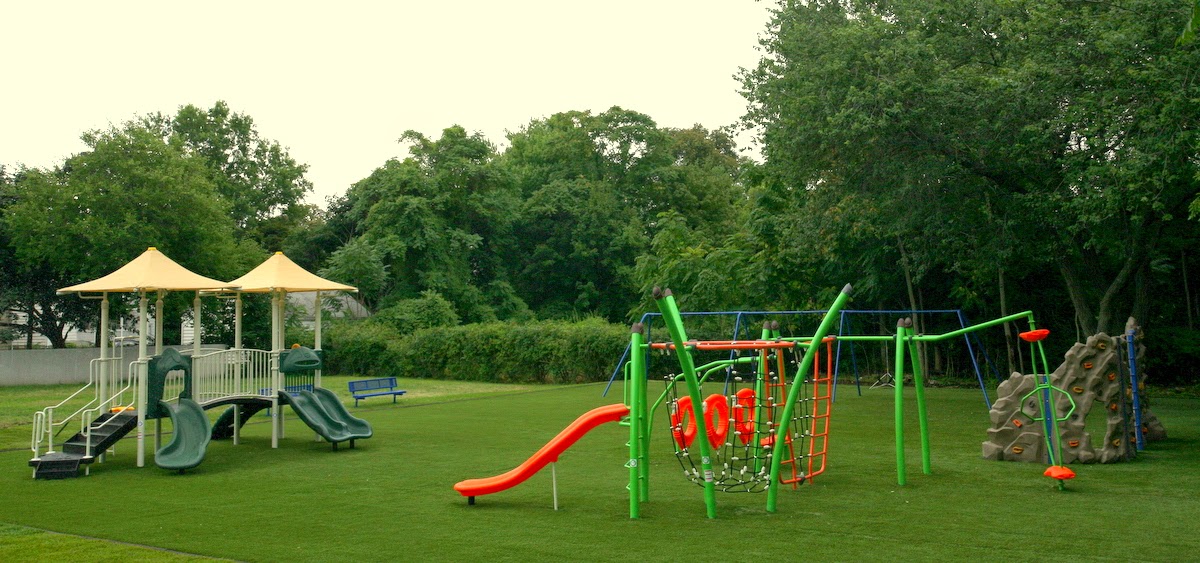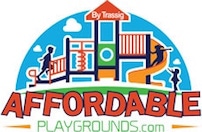Synthetic Turf Installation
Synthetic Turf Installation Instructions
Materials Needed
- Silica Sand: 1.5 pounds per square foot
- 40D 6” Long Landscape Nails

- Seaming Tape
- Seaming Adhesive
- Rotary Brush or Hard Bristle Brushes
- Seed Spreader
- Sharp Utility knife
- ¾ inch or smaller crushed stone. (or RCA)
- Stone Dust
- Edged Trowel
- Blower
- Garbage Bags
- Hammers
- Plate Compactor
- Wheel Barrows
- Pointy and square shovels
Instructions
1. Identify and mark off the area that you will install Artificial Lawn on with an outdoor spray can marker. Consider the dimensions of your Artificial Lawn to try to get as few seams as possible with your layout.
2. Remove sod with shovels, using/renting a gas powered sod puller or engaging a local landscaper to remove the sod. You will want to remove approximately 2” to 3” of soil. Ideally, you should slightly pitch the sub-base towards the best direction to allow for water drainage to run-off. Also, after the sub-base and Synthetic Turf are installed, you will want to have the edges of the Artificial Lawn at an even level with the natural landscape.
3. Cap Sprinklers. Turn off valves.
4. Compact existing ground to “firm it up fully” (you can rent a vibrating plate compactor at most rental centers).
5. Spray weed/grass killer and place a weed barrier mesh down (not always necessary in all areas of the country, such as in the desert).
6. Sub-Base: It is very important to ensure the sub-base is completely dry before laying any rock aggregate to reduce settling and ensure proper compaction for the surface. Once you confirm that the sub-base is dry, add a top layer of rock aggregate (1/4″ minus is best so you don’t feel any protruding rocks when you walk on your Artificial Lawn) – – ask your local nursery or rock yard what material local landscapers use under paving bricks, etc.
The purpose is to firm and level your base. 1″-3″ of base is usually enough, although in some areas of the country where soil is especially unstable you may need up to 5” of base material; just ask a local expert like a nursery, landscape center, or rock yard if you are not sure. *** Please note if you use more than 3” of base material, you will also need to increase the amount of soil removal.
7. Spread, and then compact the sub-base material twice. Use the vibrating compactor again.
8. Top Based Sand. Spread a fine layer of sand (approx. 1/8″ using just an ordinary seed drop spreader) on the surface to make it more level. 50lb. bags of “play sand” are available at large home improvement stores for a low cost. You may also use a water-filled (250 lb.) sod roller for an even more level surface. You can rent these for very little cost.
9. Check surface for depressions. Any depression areas 1/8″ – 1/4″ or deeper should be filled-in and re-leveled. Although the turf also drains vertically through the drainage holes that are manufactured in the fake grass, it is still advisable to give the sub-base a slight slope, to avoid any pools of water (slope away from buildings).
10. Roll out Turf. Position the fake grass where it goes; be accurate (so you don’t cut off turf you actually need). Note: Try to avoid dragging the turf.
11. Cut the turf. Cut off excess material so it’s easier to work with. Always use a sharp blade in your utility knife! Make sure to position turf where it is suppose to go. Now, trim turf more exactly with straight lines. For optimal performance and beauty, make sure to install the turf exactly over the base you prepare.
12. Seaming. Where two pieces of turf come together you will need to make a seam. At the joining seam, a 12” wide piece of seaming tape should be cut to the length of the seam. Lay the turf seam to seam to ensure it fits tightly together before you glue it. Note: The pattern of turf stitching on the under side must run in the same direction before you adhere the two pieces. You must pull back both sides of the turf at the seam in order to install the seam tape. Note: Before adhering both pieces ensure that you properly trim, straighten, and match up the edges perfectly. Lay the seam tape down on the base directly between the two pieces of turf that you will join.
Apply gluing compound to the entire piece of seam tape with a notched trowel. Place one side of the turf in the middle of the tape (approximately 6”) to the center of the tape. Lay the other side of the turf over the middle of the seam tape to match up exactly to the turf that has just been adhered to the tape. Mesh the fibers together with fingers or brush. Note: Allow 24 hours for glue to properly dry. The following procedures can be administered during the drying time, but turf may shift and require repositioning.
13. Infill Preparation. Once glue has dried, trim off turf so your lawn fits as desired. Next, it is a good idea to nail the perimeter every 1-2 feet with 40-60d nails (4-6 inch length). In order to prepare adding the infill to the turf, rake or power broom the turf in the opposite direction that the turf is laying on the roll. This will allow the infill material to infiltrate the turf rapidly and prevent turf blades from getting trapped underneath.
14. Artificial Lawn Infill. The infill process will now commence using a standard seed drop spreader with either sand or crumb rubber as an infill. The infill helps to weigh the turf down, and stabilize the fibers so as to help avoid “matting”. Most use sand infill as it is the least expensive (approx. $3 for a 50lb. bag compared to rubber infill approx. $10 for a 50lb. bag).
Of course rubber is more shock absorbent than sand, so choose what you can afford and prefer, although it is advisable to have at least the top half in rubber infill. You want to calculate the amount of infill in advance, as you will want to leave 5/8” (+/- 1/8”) of grass blade exposed. As a general rule of thumb, approximately 1 ½ pounds of sand equals ½ inch of infill height. For a rubber crumb infill, use a 10-20 mesh rubber with approximately 1 pound of rubber per sq. ft. for every 1/2” of infill height.
Spread the infill in several passes. As you spread the infill you should make one entire pass on the surface then sweep it down into the fibers, repeating the process until all of your infill has been spread.
15. Optional Edging around Artificial Lawn. Depending on your yard, you may want to install some type of edging material around your new artificial lawn. Examples are natural stone, rock borders, metal edging and plastic edging (similar to what is used around flower beds) are popular. If not, new natural grass may be laid around the area to provide proper tie-in and to ensure the best appearance.
See some of our synthetic turf install projects here.

